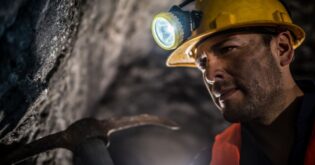DOL’s New Rule to Limit Coal Miner’s Exposure to Silica Dust
April 22, 2024 Black lung disease, which occurs when a person inhales coal dust – particularly silica dust – is most common among coal miners. Because of this, it is often considered an occupational disease. Although there is a wealth of information on how dangerous inhalable silica is and documenting the multitude of harm that it causes, allowable exposure limits have long provided inadequate protection to at-risk workers. Last week, the Acting Secretary of the Department of Labor (DOL), announced her department’s final ruling on silica exposure in mines and the news is good for workers and their families: the ruling cuts the allowable amount of airborne silica in half and aims to provide much more comprehensive protections to coal miners.
Black lung disease, which occurs when a person inhales coal dust – particularly silica dust – is most common among coal miners. Because of this, it is often considered an occupational disease. Although there is a wealth of information on how dangerous inhalable silica is and documenting the multitude of harm that it causes, allowable exposure limits have long provided inadequate protection to at-risk workers. Last week, the Acting Secretary of the Department of Labor (DOL), announced her department’s final ruling on silica exposure in mines and the news is good for workers and their families: the ruling cuts the allowable amount of airborne silica in half and aims to provide much more comprehensive protections to coal miners.
What is Black Lung Disease? Overview, Symptoms, Complications and Prognosis
Black lung disease, also known as coal miner’s pneumoconiosis, is a disease that results from inhaling coal dust. Coal dust is comprised of hazardous carbon-containing particles; shockingly, silica dust is roughly 20 times more dangerous than coal dust. The dust particles that someone breathes in remain in their lungs and cause inflammation and or/fibrosis (or scarring) over time. According to the American Lung Association (ALA), approximately 16% of coal miners develop black lung disease. However, cases are currently on the rise so the number may very well be growing.
More often than not, symptoms of black lung disease take years to develop. The ALA reports that some of the most common symptoms include:
- Cough, shortness of breath, and chest tightening are some of the most common symptoms that individuals experience in the early stages of black lung disease. Coughing may also produce black sputum or mucus. These symptoms will usually only present after strenuous physical activity in the early stages, but as the disease progresses they are more likely to be present during periods of rest as well
- People with progressive and severe black lung disease may also have low blood oxygen levels. This is because the lung scarring is so significant that it hinders oxygen from easily reaching the blood stream, which puts stress on other organs like the heart and brain
Black lung disease can cause severe health complications, including chronic bronchitis, chronic obstructive pulmonary disease (COPD), cor pulmonale (failure of the right side of the heart), respiratory failure and more. Unfortunately, there is no cure for black lung disease. Individuals who suffer from the condition often require routine doctor’s visits and are likely to experience symptoms that worsen over time. Some people also require supplemental oxygen. Research shows that on average, coal miner’s pneumoconiosis reduces a person’s life expectancy by 12.6 years.
The DOL’s New Exposure Rule
The DOL’s new exposure rule not only halves the current allowable exposure limits to 50 micrograms per cubic meter of air, but the ruling also requires that mine operators rigorously monitor silica dust levels. If levels exceed the limit, mine operators must act immediately to rectify the situation and protect workers from incurring additional exposure. In addition, mine operators must also file a report with the Mining Safety and Health Administration (MSHA) right away if they observe levels exceeding the new limit. To assist with operations and monitoring, the MSHA hired 270 inspectors who will work to ensure that mines around the nation are maintaining safe and healthful work conditions.
What to Do if You Develop an Occupational Illness
If you suspect that your job or workplace caused you to develop black lung disease, make sure you report your illness to your employer. There are strict time limits for reporting the injury or illness. To protect your rights, you should immediately speak with a workers’ compensation attorney.
Because employers are legally obligated to provide workers with a workplace free from recognized and known hazards, employees are entitled to receive benefits when they are injured or become ill from a work-related accident or exposure. Workers’ compensation is a type of insurance that provides medical benefits and wage replacement to injured or ill workers. Workers’ compensation does not replace all of the wages lost by an injured worker, only a percentage. Workers’ compensation also does not compensate for noneconomic damages that an ill worker may experience, like pain and suffering. This is why it is best to speak with an experienced workers’ compensation attorney if you develop black lung disease from working in coal mines. The attorneys at our firm can help you navigate your claim and fight for you to receive benefits that will help you into the future. If you would like to learn more, contact a representative online now.
Philadelphia Workers’ Compensation Lawyers at Galfand Berger, LLP, Representing Injured Victims Since 1947
If you have questions about filing a claim for injuries you sustained, contact the Philadelphia workers’ compensation attorneys at Galfand Berger LLP today. Call us at 800-222-USWA (8792) or fill out our online form for a free consultation. Located in Philadelphia, Bethlehem, Lancaster, and Reading, we serve clients throughout New Jersey and Pennsylvania, including Allentown and Harrisburg.
 Google Screened
Google Screened
